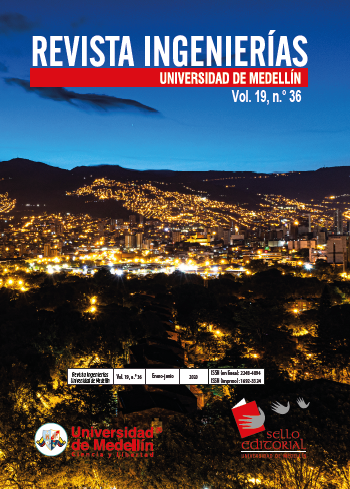Ablative Composites of Polymeric Matrix (Polyester Resin) Reinforced With Industrial Residue Materials and Fiberglass
Main Article Content
Abstract
Ablative materials are used in thermal protection systems to protect equipment or elements that are exposed to high temperatures in service. Generally, these materials are difficult to acquire and high cost, which hinders their application in countries such as Colombia. This research describes the obtaining and characterization of ablative composite materials based on a polyester resin matrix reinforced with particulate materials (60-70% by weight) and short glass fiber (5% by weight). Ceramic powder and finely ground aluminum slag were used as particulates (˂75 μm), highlighting that both are industrial waste or by-products. The developed composites were subjected to the direct flame test in order to evaluate their ablative performance, simulating the real extreme conditions (1600-2000 °C) of the nozzle of a rocket (probe type). In addition, the effect of the ablative test on the level of cracking and erosion (weight loss) of the composites developed was evaluated. As an indirect measure of the residual mechanical performance of the ablative composites, the hardness of the thermally affected area was determined. The results obtained are considered of great importance for the production of thermal protection systems and propulsion components with low cost and available raw materials in Colombia.
Article Details
References
[1] NASA. 'Sistema y materiales de protección termica (TPS),' Centro de Investigación Ames, [En línea]. Disponible: https://www.nasa.gov/centers/ames/spanish/research/humaninspace/humansinspace-thermalprotec.html, 2008.
[2] J. Maldonado Villa, J. Portocarrero Hermann, C. Rodríguez Adaime, J. J. Valbuena Cocunubo y M. E. Acuña Lizarazo, 'Evaluación del comportamiento térmico de materiales compuestos de matriz polimérica en prototipos de toberas para cohetes de órbita baja,' Rev. Cient. Gen. José María Córdova, vol. 12, n.° 13, pp. 275-290, 2014. doi: https://doi.org/10.21830/19006586.163
[3] J. Maldonado Villa, J. Portocarrero Hermann, E. Quitian Barrios, J. Alarcón Orduz y W. David Boada, 'Desarrollo de toberas de cohete en material ablativo de matriz polimérica reforzada estructuralmente con fibras de vidrio y carbono,' en 71o Congresso Anual da ABM-Internacional e ao 16o Enemet - Encontro Nacional de Estudantes de Engenharia Metalúrgica, de Materiais e de Minas, pp. 984-995, 2016.
[4] P. J. Astola, M. A. Rodríguez, F. J. Botana y L. González-Rovira, 'Caracterización de elementos de protección térmica de materiales compuestos mediante análisis térmicos,' Rev. la Asoc. Española Mater. Compuestos, vol. 2, n.° 4, pp. 34-41, 2017.
[5] M. Natali, J. M. Kenny y L. Torre, 'Science and technology of polymeric ablative materials for thermal protection systems and propulsion devices : A review,' Prog. Mater. Sci., vol. 84, pp. 192-275, 2016. doi: https://doi.org/10.1016/j.pmatsci.2016.08.003
[6] E. S. Rodríguez, 'Desarrollo de materiales compuestos avanzados basados en fibras de carbono para la industria aeroespacial,' An. la Acad. Nac. Ciencias Exactas, Fis. y Nat., vol. 64, pp. 1-6, 2012.
[7] M. L. Aranzazu Rios, V. P. Muñoz Cárdenas, M. J. Giraldo, Cárdenas, G. H. Gaviria y F. A. González Rojas, 'Modelos cinéticos de degradación térmica de polímeros: una revision,' Rev. Ing. Univ. Medellin, vol. 12, n.° 23, pp. 113-130, 2013. doi: https://doi.org/10.22395/rium.v12n23a9
[8] A. Krzyzak, W. Kucharczyk, J. Gaska y R. Szczepaniak, 'Ablative test of composites with epoxy resin and expanded perlite,' Compos. Struct., vol. 202, , pp. 978-987, 2018. doi:10.1016/j.compstruct.2018.05.018
[9] L. Asaro, L. B. Manfredi, S. Pellice, R. Procaccini y E. S. Rodriguez, 'Innovative ablative fire resistant composites based on phenolic resins modified with mesoporous silica particles,' Polym. Degrad. Stab., vol. 144, pp. 7-16, 2017. doi: 10.1016/j.polymdegradstab.2017.07.023
[10] D. Quiñonez, Y. Lizcano, C. Vaquez, J. Maldonado y J. Portocarrero, 'Construcción y evaluación de una tobera a escala menor basada en material compuesto para cohetes de órbita baja,' Rev. inge@UAN, vol. 2, n.° 4, pp. 13-21, 2012.
[11] W. Kucharczyk, D. Dusiński, W. Żurowski y R. Gumiński, 'Effect of composition on ablative properties of epoxy composites modified with expanded perlite,' Compos. Struct., vol. 183, pp. 654-662, 2018. doi: 10.1016/j.compstruct.2017.08.047
[12] G. Pulci, L. Paglia, V. Genova, C. Bartuli, T. Valente y F. Marra, 'Low density ablative materials modified by nanoparticles addition: Manufacturing and characterization,' Compos. Part A Appl. Sci. Manuf., vol. 109, pp. 330-337, 2018. doi: 10.1016/j.compositesa.2018.03.025
[13] L. Mohan Kumar, K. M. Usha, E. N. Anandapadmanabhan, and P. Chakravarthy, 'Effect of fibre orientation on the properties and functional performance of ablative materials for solid rocket motors,' Trans. Indian Inst. Met., vol. 70, n.° 9, pp. 2407-2413, 2017. doi: https://doi.org/10.1007/s12666-017-1102-1
[14] ASTM International, 'ASTM E285, Standard test method for oxyacetylene ablation testing of thermal insulation materials,' 2015.
[15] ASTM International, 'ASTM 2583, Standard test method for indentation hardness of rigid plastics by means of a barcol impressor,' 2013.
[16] G. P. Suton y O. Biblarz, Rocket Propulsion Elements, 8th ed. New Jersey: John Wiley & Sons, INC., 2010, 786 p.





